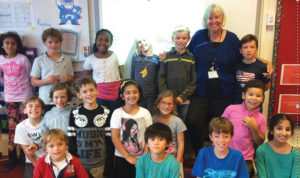Meet Meredith Tutching, Director of the Forest of Reading
 Each year, writers, illustrators, educators and other book lovers wait with bated breath for the annual Forest of Reading® shortlists to be announced. I was curious about how the Forest of Reading came about and what it takes to run this successful program so I sat down with Meredith Tutching, the program’s director.
Each year, writers, illustrators, educators and other book lovers wait with bated breath for the annual Forest of Reading® shortlists to be announced. I was curious about how the Forest of Reading came about and what it takes to run this successful program so I sat down with Meredith Tutching, the program’s director.
What is the Forest of Reading?
The Forest of Reading is Canada’s largest recreational reading program. This initiative of the Ontario Library Association (OLA) offers eight reading programs to encourage a love of reading in people of all ages. The Forest celebrates Canadian books, publishers, authors and illustrators. More than 250,000 readers participate annually from their school or public library.
When did the Forest of Reading begin?
The program began with the Silver Birch award in 1993 (Grades 4 – 6) and over the next decade programs were continually added as they attracted attention of principals, school boards and public libraries across Ontario.
The exposure to books is immense. In the 1990s individual tree programs had their own small ceremonies with hundreds of kids in Toronto. In 2007, OLA teamed up with the International Festival of Authors to create the Festival of Trees and present all awards in one location. This is now the largest children’s literary event in Canada. In 2015, the Toronto Festival and satellite Forest events were attended by 20,000 young readers.
How did you first get involved in Forest of Reading?
I began working at the OLA in 2001. I was supposed to be here for three weeks in between traveling and graduating from Queen’s University—but I haven’t left! My role evolved at OLA over the years and I have worked in almost every department. By 2008, the Forest of Reading was 30% of my job. I really felt the program needed a full-time position. There was so much more to do and the potential to grow the program. Every day since then I consider myself very lucky to have a job I love.
How many books are considered in any given year?
Over 700 books are submitted. The number increases every year.
How many volunteers does it take to make the Forest run?
Over 400 volunteers are part of the Forest of Reading. Volunteer roles are anywhere from a day at the festival to months of reading in advance. We have selection committees that select nominated titles, the steering committees who work with authors once the list has been confirmed, and then the Festival of Trees volunteers. These people make sure all events run smoothly and thousands of kids have a blast while celebrating our nominees.
How many students are involved?
Over 250,000 are involved, but getting the exact number is hard to determine because of the nature of our program. In 2015 we had 156,000 active voters but there are many kids who don’t read the minimum of 5 of 10 books to be eligible to vote, but who are active in the program. We still face a challenge of schools that run the program but don’t register and this is becoming increasingly problematic. The programs are trademarked/registered and we try to enforce this to secure corporate sponsorship to make the program cheaper on many levels. Registration is only about $30 for an institution.
You recently expanded beyond Ontario. Can you tell me about that?
We have had several provinces show interest in the Forest, in addition to Canadian international schools. Many of these places are keen on our programs based on the selection process and that our nominees are not focused on authors from one province. In the school-aged programs the books must have a Canadian author and be published in the last two years. Our selection committees follow criteria that many outside of Ontario are interested in. In 2014/2015 we had schools outside of Ontario: Nunavut, Manitoba, Alberta, Quebec, Trinidad & Tobago, China, Hong Kong and the Netherlands. We are hoping for even more in 2016.
Can you tell me about the French program?
The French programs within the Forest of Reading are the fastest growing of our “trees.” Le Prix Peuplier, Tamarac and Tamarac Express Award programs had almost 300 institutions involved in 2015 (up 20% from 2014). Expansion of French immersion has been a contributing factor, plus the fact that our selection committees are curating a list of thirty current, great French-Canadian books for schools and libraries. The expansion of the Festival of Trees to include an all French Festival offering great programming, almost twenty francophone authors, amazing entertainment and new field trip opportunities, has been a great addition for schools.
How is the Forest of Reading different from other Canadian book awards?
There are over sixty children’s book awards in this country, however there are only a handful of these that are children’s choice awards. It is very important to the kids to be able to vote. Surprisingly, every year what adults think are the best books on the list are not the ones that win. Winning authors repeatedly tell us that winning a Forest Award program means they are doing something right! Kids are brutally honest, and winning is proof that your books are a success in this genre. This gives authors the confidence to keep writing, especially new authors.
What has been the response from educators, authors, parents, librarians and kids?
Educators, librarians and library staff are engaged in the program and over the next few years we really want to connect with more teachers and parents through some initiatives we have in the works. Authors love the program for a variety of reasons—sales, exposure, audience, etc. And the kids—well, one day at the Festival of Trees will tell you that they are HUGE fans.
What are the biggest challenges you face?
Taking over the universe! The programs are popular and wonderful, but could be so much more amazing with more marketing and getting the programs in the minds of every Canadian. We want every school board and public library in this country involved. There are great programs across the country, but most provinces don’t have programs for all ages. We do, and we want to fill gaps where there is a need.
Additionally, in many provinces, school libraries are eroding and this is something the Ontario Library Association is working hard to advocate against. The Forest has been traditionally run through a trained library professional in a school library, but times are changing yearly.
What is your book selection process?
Books are submitted year round to our official wholesaler. For 2015–2017 this is Tinlids Inc. The books are sent with a submission form and they work with each of the Selection Chairs to route the books to the committee members. Each “tree” has a different timeline, but they all finish their reading in July or August and come up with their top ten list. We then work with the publishers to ensure they have the right quantity for the program (due to sales, many publishers need to reprint for this program). The list is announced on October 15th each year.
Once a book is shortlisted, what comes next?

2016 Silver Birch nominee Margriet Ruurs with students.
Committee members work with the authors and publishers to get information to the websites. The lists are announced on October 15th, but it is in December that the programs get underway in schools, libraries and at home. Getting books into the schools, on devices and into circulation takes some time. The program was originally intended to run starting in the new year, but with increasing popularity some start right after the announcement. At OLA we think of December 1st as the start of the official program for readers, as that is when we have over 500 resources available for readers to access about the books, authors, etc.
Once the programs are up and running, we encourage schools and libraries to host Forest author visits through OLA’s partner, Authors’ Booking Service. It is a very exciting time for everyone involved. And of course we hope to see all of the nominees at the Festival of Trees in Toronto and the other locations.
What are you most proud of?
The growth of the Festival of Trees in Toronto and the fact it is now moving around the province. Every year I comment that 50% of my job stays the same and 50% is new and innovative. I am proud of what we do here at OLA and being able to expand and grow makes this job very rewarding.
If you had one wish, what would it be?
For the Forest of Reading to be run in schools and libraries across the country, for it to be a recognizable in every household (I think that was two wishes!).
For more information and to participate check out:
forestfestivaloftrees.ca
authorsbooking.com
First published in CANSCAIP News, Vol.37, No. 4, reprinted with permission.
ABOUT THE AUTHOR
Marsha Skrypuch
Marsha Skrypuch’s 20th book is Adrift at Sea: A Vietnamese Boy’s Story of Survival, with Tuan Ho, illustrated by Brian Deines (Pajama Press), fall 2016.
This article is from Canadian Teacher Magazine’s Apr/May 2016 issue.












